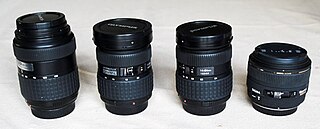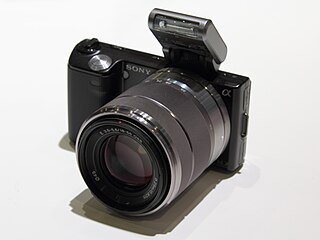
Carl Zeiss AG, branded as ZEISS, is a German manufacturer of optical systems and optoelectronics, founded in Jena, Germany in 1846 by optician Carl Zeiss. Together with Ernst Abbe and Otto Schott he laid the foundation for today's multi-national company. The current company emerged from a reunification of Carl Zeiss companies in East and West Germany with a consolidation phase in the 1990s. ZEISS is active in four business segments with approximately equal revenue in almost 50 countries, has 30 production sites and around 25 development sites worldwide.

Minolta Co., Ltd. was a Japanese manufacturer of cameras, camera accessories, photocopiers, fax machines, and laser printers. Minolta Co., Ltd., which is also known simply as Minolta, was founded in Osaka, Japan, in 1928 as Nichi-Doku Shashinki Shōten. It made the first integrated autofocus 35 mm SLR camera system. In 1931, the company adopted its final name, an acronym for "Mechanism, Instruments, Optics, and Lenses by Tashima".

Sigma Corporation is a Japanese company, manufacturing cameras, lenses, flashes and other photographic accessories. All Sigma products are produced in the company's own Aizu factory in Bandai, Fukushima, Japan. Although Sigma produces several camera models, the company is best known for producing high-quality lenses and other accessories that are compatible with the cameras produced by other companies.

The Pentax K-mount, sometimes referred to as the "PK-mount", is a bayonet lens mount standard for mounting interchangeable photographic lenses to 35 mm single-lens reflex (SLR) cameras. It was created by Pentax in 1975, and has since been used by all Pentax 35 mm and digital SLRs and also the MILC Pentax K-01. A number of other manufacturers have also produced many K-mount lenses and K-mount cameras.

Sony α is a digital camera system introduced on 5 June 2006. It uses and expands upon Konica Minolta camera technologies, including the Minolta AF SLR lens mount, whose assets were acquired by Sony after the end of Konica Minolta's photography operations in early 2006. Sony also has an 11.08% ownership stake in Japanese lens manufacturer Tamron, which is known to have partnered with Konica Minolta and Sony in the design and manufacture of many zoom lenses.

The Minolta AF Zoom 70–210mm f/4 lens is an autofocusing telephoto photographic lens compatible with cameras using the Minolta AF lens mount.

Originally produced as Konica Minolta AF Zoom DT 18-70mm f/3.5-5.6 (D) by Konica Minolta, and later produced by Sony, the Sony α DT 18-70mm f/3.5-5.6 (SAL-1870), is a photographic lens compatible with cameras using the Minolta A-mount and Sony A-mount lens mounts. The DT designation means this lens is designed to be used with a camera with an APS-C size sensor. When the 1.5× crop factor is considered, the lens has an effective equivalent 27–105mm focal length.

Originally produced by Minolta, and currently produced by Sony, the STF 135mm f/2.8 [T4.5] is a photographic lens compatible with cameras using the Minolta AF and Sony α A-mount. STF stands for Smooth Trans Focus, in reference to its special optical system, which is intended to smooth the transition between the plane of focus and out-of-focus areas in the image. This is accomplished by the use of an apodization filter that provides the high-quality bokeh effect. The lens is not a soft-focus lens.

The Minolta A-mount camera system was a line of photographic equipment from Minolta introduced in 1985 with the world's first integrated autofocus system in the camera body with interchangeable lenses. The system used a lens mount called A-mount, with a flange focal distance 44.50 mm, one millimeter longer, 43.5 mm, than the previous SR mount from 1958. The new mount was wider, 49.7 mm vs. 44.97 mm, than the older SR-mount and had a longer flange focal distance making old manual lenses incompatible with the new system. Minolta bought the autofocus technology of Leica Correfot camera which was partly used on the a-mount autofocus technology. The mount is now used by Sony, who bought the SLR camera division from Konica Minolta, Konica and Minolta having merged a few years before.
Originally produced by Minolta, then by Sony, the AF Reflex 500mm f/8 was a catadioptric photographic lens compatible with cameras using the Minolta A-mount and Sony A-mount lens mounts.

The Minolta AF Macro 100 mm f/2.8 lens is a discontinued macro lens produced by Minolta that was renowned for its sharpness all the while garnering raving reviews also. This lens achieves a true 1:1 magnification of the subject matter of interest to the photographer. While still having an aperture of f/2.8 coupled with its focal length of 100 mm, it is considered a double duty lens for macro photography and portraiture/portrait photography. It works in conjunction with Minolta's own flash metering system called Advanced Distance Integration (ADI). This macro lens is known as a D lens that works in combination with the D series flash units and select Maxxum camera bodies for the ADI system. ADI flash distance metering and execution of the ADI flash units allows for a more balanced lighting of the subject matter, thereby allowing the Minolta AF 100 mm to perform admirably well in a situation needing a flash. This popular lens offers advanced features and is still offered by its new creator/manufacturer, Sony, to this day. Sony's 2006 production and current version of this lens is based on the Minolta AF Macro 100 mm lens, all the while being identical with the exception of their respective company's markings.

This article is about photographic lenses for single-lens reflex film cameras (SLRs) and digital single-lens reflex cameras (DSLRs). Emphasis is on modern lenses for 35 mm film SLRs and for DSLRs with sensor sizes less than or equal to 35 mm ("full-frame").

The E-mount is a lens mount designed by Sony for their NEX and ILCE series of camcorders and mirrorless cameras. The E-mount supplements Sony's α mount, allowing the company to develop more compact imaging devices while maintaining compatibility with 35mm sensors. E-mount achieves this by:

The Sony α NEX-5 is a digital camera launched on 11 May 2010. It is a mirrorless interchangeable lens camera with the body size of a larger model fairly compact point-and-shoot camera with a larger sensor size (APS-C) comparable to that of some digital single-lens reflex cameras. Its major competitors in the market are the cameras based on the micro 4/3 standard created by Panasonic and Olympus, and a few low end Canon, Nikon, and even Sony α DSLRs. The NEX-5 shoots 14.2 megapixel stills and has a 7 frame/s continuous shotmode. It has the capability to shoot 1920×1080i at 60 frame/s in AVCHD or 1440×1080p at 30 frame/s in MPEG4. The NEX-5 was replaced by the 16 megapixel NEX-5N in August 2011.

The Fujifilm X-mount is a type of interchangeable lens mount designed by Fujifilm for use in those cameras in their X-series line that have interchangeable-lenses. These lenses are designed for 23.6mm x 15.6mm APS-C sensors.

The Sony Zeiss Planar T* FE 50mm F1.4 ZA is a large-aperture, standard full-frame prime lens for the Sony E-mount. It was released by Sony in July 2016.
















